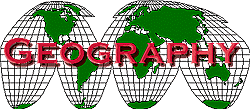Title of Course
Sophomore Geography
Instructor
Dave Stutz
email: dstutz@kusd.kusd.edu
or click here
web page: http://www.stutzfamily.com/mrstutz
Prerequisite
None
Course Objectives and Description
Sophomore geography is
a one-semester class designed to introduce the five themes of geography
and their implications/effects on humans and the environment as well as
familiarizing the students with applications of geographic tools. Areas
of emphasis include continents and countries as they relate to environmental
issues, population, resource distribution, elements of physical geography
such as landforms, climate, and water, cultural geography, and land utilization.
The course will stress
the five themes of geography as presented by the National Council for Geographic
Education while focusing on world regions and the environment. Students
will gain an understanding, through cross-curricular activities with their
science classes, of the impact and effects of human beings on the physical
and cultural geography of the world. Students will also be introduced to
a variety of geographic tools including fundamentals of map projections,
urban and land planning, and geographic information systems (GIS).
Course Standards/Outline/Calendar
A. Introduction to Geography
-
KUSD SS Standards #20.3,
20.4
-
Weeks 1-3
-
Map: continents, lines, and
oceans
-
Uses/careers
-
Geographic Terms
-
Charts and graphs
B. Location
-
KUSD SS Standards #20.3,
20.4
-
Weeks 4-5
-
Map: North & South America
-
Absolute vs. Relative
-
Latitude/longitude
-
Location quizzes
-
"Where in the World is Mr.
Stutz?"
-
Basic mapping
-
Guidelines
-
Room Map project
C. Place
-
KUSD SS Standards #20.2,
20.4, 21.1, 23.2, 23.4
-
Weeks 6-8
-
Map: Europe
-
Natural/Cultural Features
-
Resource distribution
-
Using geographic information
to plan actions
-
Hasta city planning activity
-
Drugs Project
D. Human/Environmental Interaction
-
KUSD SS Standards #20.2,
22.1, 22.3, 23.2, 23.3
-
Weeks 8-11
-
Map: Africa
-
Population
-
Population Pyramids
-
Age-sex ratio
-
Growth rates
-
Food and energy use
-
Comparison of regional use
-
Natural resource implications
-
Ancient cultures’ examples
-
Disease
-
Geographic solutions (cholera)
-
Geographic tracking (AIDS)
E. Movement and regions
-
KUSD SS Standards #21.3,
22.1, 22.3, 23.5
-
Weeks 12-15
-
Map: Asia
-
People: migrations, slave
trade to the south
-
Goods: transportation routes
to hubs
-
Things: disease patterns
of infection in LDCs
-
Ideas: independence movements
after WWII
-
Natural: weather patterns
in the Pacific
-
Global: plate tectonics
F. Geographic Information
Systems (GIS)
-
KUSD SS Standards #20.3,
22.1
-
Weeks 16-18
-
Map: Oceania
-
Introduction
-
Uses
-
Population growth project
Materials:
-
Class text: Fraser, C. (1993).
Unlocking the Five Themes of Geography.
-
Class atlas: (1997) Students
Quick Reference Atlas from Cram
-
Assignment Notebook
-
A three ring binder, loose-leaf
paper, and pen/pencil daily
-
5 floppy discs (PC formatted)
and a plastic disc protector
-
1 manila folder
-
Additional resources and
readings as supplied in class
General Information about homework and
other assignments
Grades in the class are
not weighted. That means that points are worth exactly the same, whether
on a test, quiz, homework, or in-class assignment.
As a general rule:
-
In-class assignment = 5-10
points
-
Reading/Question set = 10-20
points
-
Test/Quiz = 25-50 points
-
Presentation/PowerPoint =
25-50 points
It is very important that
all assignments are completed, as those points do add up. No student that
has turned in all assignments has ever failed. This is not because
of a mercy policy; it is because just doing all the work puts you into
the best possible situation to do well.
Extra credit is generally
not given out, although some (unannounced) assignments may be graded as
extra credit. It is the student’s responsibility to ensure that all work
is turned in- it is of great benefit to your grade to do so!
Make up procedures and extra help
opportunities
*Mr. Stutz is always
in the school until at least 4PM. This is the single best time to meet
with him and get extra help. Make arrangements and stick around for a bit
- during the school day it is virtually impossible to meet for extra help*
Make up work can be completed
in accordance with the House of Biotechnology/Environmental Studies policy:
-
Students who miss class will
have 1 day per absence to turn work in ‘on time.’ Thereafter, the assignment
will be considered to be ‘late.’
-
Late assignments will only
be accepted within three days of the ‘on time’ due date upon receipt of
a parent/guardian phone call granting permission to accept said assignment.
Such assignments will receive a maximum grade of 82%.
-
If the work is graded on
the basis of being completed during a class period, no late work will be
accepted.
-
It is the student's responsibility
to approach Mr. Stutz to determine what work is missing and make arrangements
to redo such assignments
Grading scale
Per Kenosha Unified School
District policy, the grading scale is as follows:
-
99% and above- A+
-
95 - 98% - A
-
93 -94% - A-
-
91 - 92% - B+
-
87 - 90% - B
-
85 - 86% - B-
|
83 - 84% - C+
79 - 82%- C
77 - 78% - C-
75 - 76% - D+
72 - 74% - D
70 - 71% - D-
Below 70% - F
|
Classroom Procedures and Rules
Students at the start
of the year set class-specific rules. There are 4 general rules Mr. Stutz
expects to be followed:
-
Arrive in class on time with
paper, binder, writing utensil, and any previously designated materials
-
Students are to remain in
their seats until Mr. Stutz has dismissed the class
-
Swearing and derogatory remarks
have no place in the classroom and will not be tolerated
Accord those who are
speaking (including teachers and students) the respect, courtesy, and quiet
they deserve
|

